According to the Ministry of Agriculture and Rural Development (MARD), at present, the southern region has about 676,000 hectares of fruit trees. Tien Giang Province has so far developed an area of raw materials for production and export of fruit trees with an area of more than 83,000 hectares, with an output of 1.5 million tonnes per year. In order to ensure efficient fruit production area, Tien Giang Province has recently devised many policies to support farmers, cooperatives and businesses in expanding raw material areas.
Nguyen Van Minh, from Xom Chu Hamlet, Tan Phuoc Commune, Go Cong Dong District, Tien Giang Province,shared that in the past the rice land in the area was affected by salinity, so there were very few suitable crops. After acknowledging that dragon fruit trees can grow well and give stable economic results, his family and many other households shifted from rice to dragon fruit. Currently, his family is growing 0.7 hectares of red-flesh dragon fruit, earning an average income of over VND400 million a year.
In order to create conditions for the development of new crops, households have been supported with VND1.5 million per hectare to shift crops. In addition, the converted areas have been invested with high-voltage electricity, the transport infrastructure and irrigation system have been upgraded and expanded, Minh said, adding that local authorities have also regularly organised seminars to provide farmers with technical support on planting, care and production techniques according to safe procedures, as well as assist them in finding sources for consumption of agricultural products.
The South Central Coast region currently has more than 93,000 hectares of fruit trees. In this area, there are now a number of concentrated production areas such as dragon fruit in Binh Thuan, grapes and apples in Ninh Thuan, mango in Khanh Hoa, in addition, areas for other fruits such as pomelo and durian are also being expanded.
A number of fruit trees in the Central Highlands are growing fast and giving high economic efficiency such as durian (Lam Dong, Dak Lak, Dak Nong) and avocado (Lam Dong, Dak Lak, Dak Nong, Gia Lai). Farmers in the region have expanded the fruit tree area, especially intercropping with coffee gardens, bringing about high economic efficiency.
A representative of the MARD’s Department of Crop Production said that in recent time, the development of fruit tree areas has been attributable to the acceleration in the application of science and technology in production in localities.
On the other hand, many technical advances in farming have been applied on a scale of tens of thousands of hectares such as: spreading the harvest, grafting, renovating to replace varieties, and rejuvenating old orchards; and pruning branches to create canopy, using water sparingly, and additional pollination, among others.
Production orientations in the near future
In order to promote the effectiveness of the fruit tree areas in the South, in the coming time, localities need to strengthen management and supervision to follow the correct orientation, identify the specific area of each type of tree through the management of the planting areas associated with building a system of purchasing, preliminarily processing, processing, preserving and consuming.
In addition, it is necessary to continue to review the situation of fruit tree production in the area, identify key fruit trees that are suitable with land and ecological conditions, on the basis of reviewing and proposing policies and solutions for sustainable development, especially not developing plants outside the planning areas.
Local specialised agencies need to strengthen estimates and forecasts regarding pests and diseases on fruit trees to guide producers in timely prevention and control towardsensuring crop productivity and quality; support and promote consumption linkages with supermarket systemsboth within and outside the province; and step by step put products to sell on e-commerce platforms.
In particular, in the context of the complicated developments of the COVID-19 epidemic, localities need to continue to implement detailed plans for production and consumption of fruits to ensure output for farmers.
















